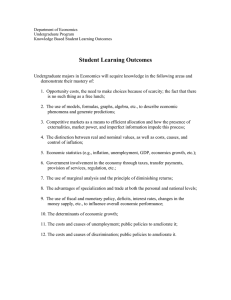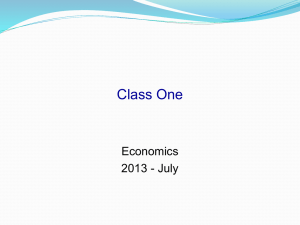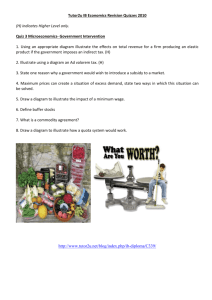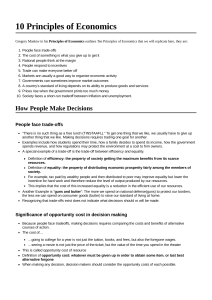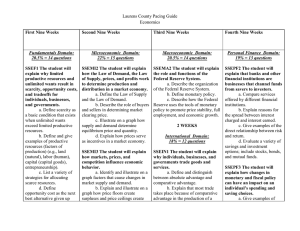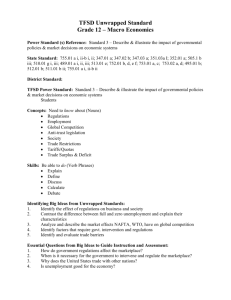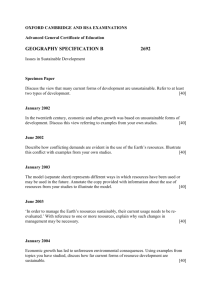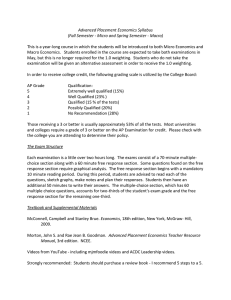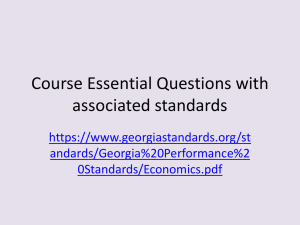Essential Questions by Unit
advertisement
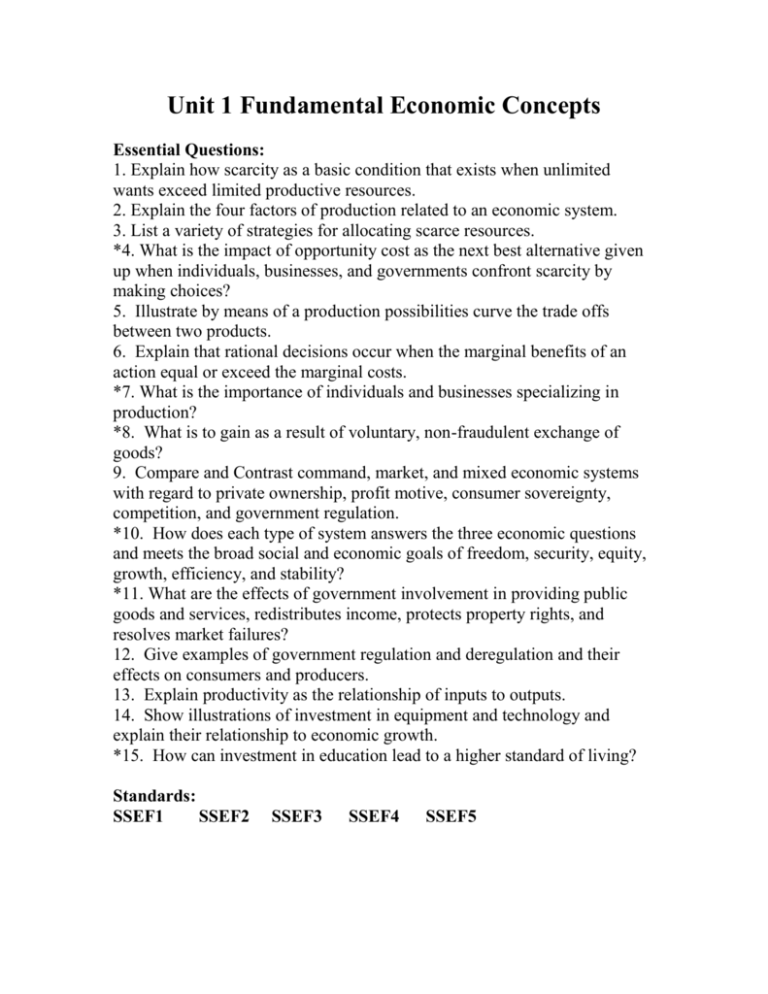
Unit 1 Fundamental Economic Concepts Essential Questions: 1. Explain how scarcity as a basic condition that exists when unlimited wants exceed limited productive resources. 2. Explain the four factors of production related to an economic system. 3. List a variety of strategies for allocating scarce resources. *4. What is the impact of opportunity cost as the next best alternative given up when individuals, businesses, and governments confront scarcity by making choices? 5. Illustrate by means of a production possibilities curve the trade offs between two products. 6. Explain that rational decisions occur when the marginal benefits of an action equal or exceed the marginal costs. *7. What is the importance of individuals and businesses specializing in production? *8. What is to gain as a result of voluntary, non-fraudulent exchange of goods? 9. Compare and Contrast command, market, and mixed economic systems with regard to private ownership, profit motive, consumer sovereignty, competition, and government regulation. *10. How does each type of system answers the three economic questions and meets the broad social and economic goals of freedom, security, equity, growth, efficiency, and stability? *11. What are the effects of government involvement in providing public goods and services, redistributes income, protects property rights, and resolves market failures? 12. Give examples of government regulation and deregulation and their effects on consumers and producers. 13. Explain productivity as the relationship of inputs to outputs. 14. Show illustrations of investment in equipment and technology and explain their relationship to economic growth. *15. How can investment in education lead to a higher standard of living? Standards: SSEF1 SSEF2 SSEF3 SSEF4 SSEF5 Unit 2: Microeconomic Concepts Essential Questions: 1. Illustrate by means of a circular flow diagram, the Product market; the Resource market; the real flow of goods and services between and among businesses, households, and government; and the flow of money. *2. What is the role of money and explain how it facilitates exchange? 3. Using the Law of Supply and the Law of Demand, describe the role of buyers and sellers in determining market clearing price. 4. Illustrate on a graph how supply and demand determine equilibrium price and quantity. *5. How do prices serve as incentives in a market economy? 6. Identify and illustrate on a graph factors that cause changes in market supply and demand. 7. Explain and illustrate on a graph how price floors create surpluses and price ceilings create shortages. 8. Explain price elasticity of demand and supply using modern goods and services. 9. Compare and contrast three forms of business organization—sole proprietorship, partnership, and corporation. *10. How is profit as an incentive for entrepreneurs? 11. Identify the basic characteristics of monopoly, oligopoly, monopolistic competition, and pure competition. Standards: SSEMI1 SSEMI2 SSEMI3 SSEMI4 Unit 3: Macroeconomic Concepts Essential Questions: 1. Explain that overall levels of income, employment, and prices are determined by the spending and production decisions of households, businesses, government, and net exports. 2. Explain how each of the following: Gross Domestic Product (GDP), economic growth, unemployment, Consumer Price Index (CPI), inflation, stagflation, and aggregate supply and aggregate demand evaluate economies. 3. Explain how economic growth, inflation, and unemployment are calculated. 4. Explain the differences between structural, cyclical, and frictional unemployment. 5. Explain the stages of the business cycle, as well as recession and depression using empirical current data. 6. Describe the difference between the national debt and government deficits. What is the global impact of each? 7. Describe the organization of the Federal Reserve System. *8. What is the purpose of our federal monetary policy? *9. What methods does the Federal Reserve use to promote price stability, full employment, and economic growth? *10. What is the purpose of creating fiscal policies? *11. What factors the government’s taxing and spending decisions? Standards SSEMA1 SSEMA2 SSEMA3 Unit 4: International Economics Essential Questions: 1. Compare and Contrast absolute advantage and comparative advantage. *2. Why does most trade take place because of comparative advantage in the production of a good or service? 3. Explain the difference between balance of trade and balance of payments. 4. Explain the effects of trade barriers as tariffs, quotas, embargoes, standards, and subsidies. *5. What are specific examples of trade barriers? Also, List specific examples of trading blocks such as the EU, NAFTA, and ASEAN. *6. What are the arguments for and against free trade? *7. What is the Global economic impact of the exchange rate? Why do some groups benefit and others lose? *8. How does the exchange rate impact Americans disposable income? Standards: International Economics SSEIN1 SSEIN2 SSEIN3 Unit 5: Personal Finance Economics Essential Questions: 1. How do people respond to positive and negative incentives in predictable ways? 2. Use a rational decision making model to select one option over another. 3. Create a savings or financial investment plan for a future goal. 4. Compare services offered by different financial institutions. *5. What is the direct relationship and risks of losses or returns when investing in a variety of savings and investment options; include stocks, bonds, and mutual funds? 6. Who benefits and who loses from inflation? 7. Compare and Contrast progressive, regressive, and proportional taxes. *8. How does an increase in sales tax effects different income groups? *9. What are the major factors that affect credit ratings? 10. Compare interest rates on loans and credit cards from different institutions. 11. Explain the difference between simple and compound interest rates. *12. What is the main purpose of having various types of insurance such as automobile, health, life, disability, and property? *13. What are the fundamental skills required to be successful in the workplace? *14. What is the significance of investment in education, training, and skills as a human capital resource? Standards: Personal Finance Economics SSEPF2 SSEPF3 SSEPF4 SSEPF5 SSEPF6
